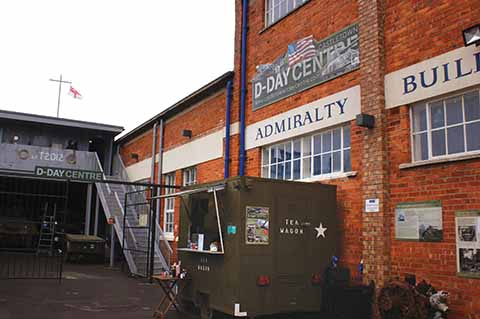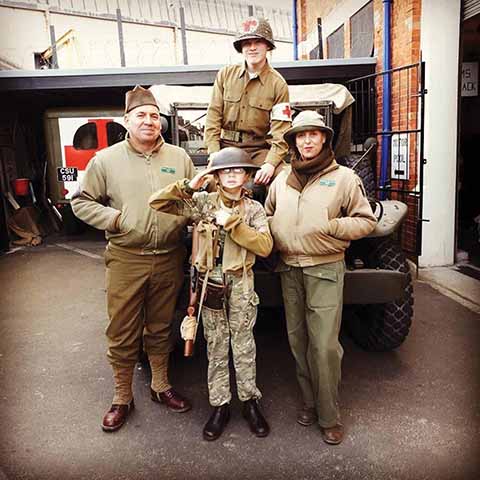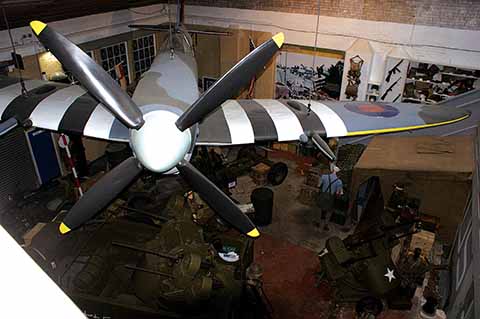Where every day is the longest day
Ray Fairclough goes being the scenes at Castletown’s D-Day Centre, and examines Dorset’s role in the preparation for and launching of the D-Day landings 75 years ago this month
Published in June ’19
As dawn broke on Tuesday 6 June 1944, Portlanders were awoken by the din of 30,000 American servicemen preparing to be shipped across the Channel to launch the Normandy landings. Attack transport ships were still being loaded, two at a time, from the stone pier. Overhead, the sky was dark with transport planes, some carrying paratroopers, others pulling gliders – it is thought that every American who took part in the airborne assault on D-Day passed over the top of Portland.
That fateful morning 75 years ago was the culmination of months of preparation that would see some 500,000 American troops and 144,000 tanks and vehicles depart Portland and Weymouth for France as part of Operation Overlord, the invasion of German-occupied western Europe.
American troops had been in Dorset in numbers since August 1943. Now, the stone pier at Portland was the focus of a vast network that reached into the rest of Dorset and beyond, with some roads leading in, others going out and strict one-way systems in place. Along the hedgerows of Dorset from Weymouth inland were boxes of ammunition, rifles, rations, vehicles, kit and equipment under cover, ready to be called up.
The Americans had built the large hard-standing car park at Ferry Bridge, just off the causeway to Portland, and that became the point of no return. Once the troops got there, they had to wait to be escorted to a ship and on to France.
Similar scenes were played out at ports and coastal towns along the south coast, including Poole, but the embarkation point at Portland was among the busiest and the US 1st Infantry (the Big Red One) was one of the first assault groups to leave the port bound for Omaha Beach, on the Normandy coast. In the first hour of fighting, chances of not becoming a casualty were no better than 50-50 – the nickname, ‘Bloody’ Omaha, tells its own story.
‘Within 24 hours of the landings, the first US casualties were brought back through Castletown,’ explains Steve George, co-founder and curator of Castletown D-Day Centre. ‘There were hospital trains in the sidings roughly where our entrance door is and a field hospital in Wyke. Later on, Allied and Axis casualties arrived at Castletown, as well as German prisoners of war who were marched up to internment camps and then taken inland.’

The Castletown D-Day Centre at Admiralty Buildings is part of the wider regeneration project. The Centre opens every day during the season and weekends during winter, but the Tea Wagon is open every day and is fast becoming a popular local landmark.
Now attracting some 20,000 visitors a year, Castletown D-Day Centre occupies a former warehouse in Admiralty Buildings owned by its co-founder and patron, Derek Luckhurst, Chairman of Agincare and the driving force behind the Castletown Regeneration Project. His family has been connected with Castletown for at least five generations. Inside the D-Day Centre, one of the model figures of real people whose stories add colour to the bigger picture is his father, ‘Lucky’. That personal connection and his resolve to revive the fortunes of Castletown led directly to the opening of the D-Day Centre in March 2017.
Steve was a coastguard before the museum came into being. ‘I only ever drove through Portland on business. I didn’t really know much about it, but, because of my interest in World War 2 and the marks it left on the towns and villages of Dorset, I realised just how significant it was.’
Meeting Derek was the catalyst for the D-Day Centre and they are both part of the effort to bring the area back to life. The project includes the award-winning Crabbers Wharf development. ‘There’s a lot of redevelopment happening now that is long overdue,’ says Steve. ‘With it comes an influx of people who don’t know about Portland’s history and I’m determined to do all I can to reclaim these stories from history and keep them alive. The centre is intended as a tribute to the people of Castletown as well as the young men who came through here on their way to war.’

Castletown D-Day Centre curator Steve George (left) in full uniform is joined by volunteers to welcome a young visitor
Six statues have been commissioned and installed on the Phoenix concrete caissons that are now the last remaining examples of the units used to build temporary Mulberry harbours after D-Day. The statues – two GIs, two British sailors and two civilian dock workers, or mateys – are visible from the vintage tea room at the D-Day Centre, part of the attraction’s latest installation that also includes a mock-up of a German defensive bunker on the Atlantic Wall.
There is a Sherman tank outside, but inside, the main building is configured as a diorama with working examples of a US M16 half-track, a 1940 BSA and Harley Davidson Flathead motorcycles. A Bofors 40mm gun sits just outside the briefing room, where visitors can watch a film about Castletown and D-Day. On the mezzanine floor there is a decommissioned jeep and above it all a replica of the Mark IX Spitfire ML407 that claimed the first enemy aircraft shot down on D-Day over Omaha Beach.
For thousands of young Americans, the last place of which they would have had any peaceful memories was Dorset. They were stationed here, some of them for months; they made lives here. For the local people, some of the friendships and relationships they made with Americans were taken away from them literally overnight.
Castletown was such an important part of the D-Day story that there is a lot of archive footage and photographs of the Americans there. ‘Because everything was so well documented,’ explains Steve, ‘we have been able to trace countless individual stories that can be read on the information boards. That human connection makes the story so much more real and we quite frequently see tears shed in here, particularly from American visitors off the cruise ships who had no idea about this history.’
www.castletownddaycentre.com
Dorset and D-Day
Blandford: In April 1944 the first of five US Army general hospitals was established at Blandford Camp to receive casualties from Operation Overlord, as many as 500 during one night. The US 1st Infantry Division HQ was at nearby Langton House.
Bournemouth: General Eisenhower, Supreme Commander of Allied Forces, met with Field Marshal Montgomery, Ground Forces Commander-in-Chief, at a Bournemouth hotel to finalise plans for D-Day.
Broadmayne: Broadmayne and West Knighton were designated as Marshalling Area D5 in the months leading up to D-Day, with some 4000 US troops billeted in the embarkation camp.
Christchurch: Planes and gliders were built at Christchurch Aerodrome in camouflaged factories. Coastal defence batteries were installed at Hengistbury Head and Mudeford.
Hamworthy: Landing craft were built round the clock at Bolson’s and Newman’s boatyards. RAF Hamworthy was a seaplane base and the first Royal Marine Commandos trained at HMS Turtle amphibious warfare centre.
Hurn: Typhoons, Mosquitoes and Martin B-26 bombers were based at the aerodrome.
Poole: The third largest D-Day embarkation point for US France-bound troops. More than 300 craft left the town, which was protected by at least 100 anti-aircraft guns.
St Leonards: The hospital, built in 1942 for American and Canadian casualties flown in to Hurn, was by 1945 also home to a PoW enclosure. In 2016 the site was developed for housing, but an oak tree planted there by Eisenhower to mark the end of the war was saved.
Studland Bay: Six weeks before D-Day, Operation Smash gathered troops in Studland to rehearse the Normandy landings. King George VI, Winston Churchill, Eisenhower, Montgomery and Louis Mountbatten witnessed the largest live-fire practice of the war from the Fort Henry observation bunker.
Swanage: The beach was mined and laden with barbed wire as many of the town’s hotels and homes became barracks and billets.
Tarrant Rushton: British Army 6th Airborne Division took off from here on D-Day to lead the air assaults. Royal Signallers based at Tarrant Rushton were among the first troops to land in France and Airborne signallers played a critical part in the taking of Pegasus Bridge over the Caen Canal. Night flights dropped supplies for the French Resistance and Special Operations Executive.
Verwood: Sandpits at Stephens Castle were quarried to build the Phoenix caissons used to make Mulberry harbours.



